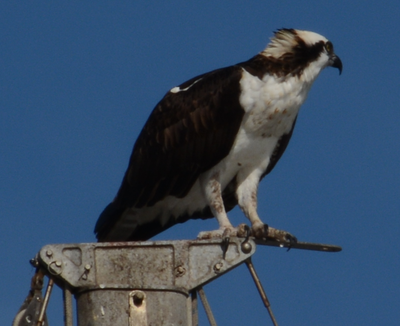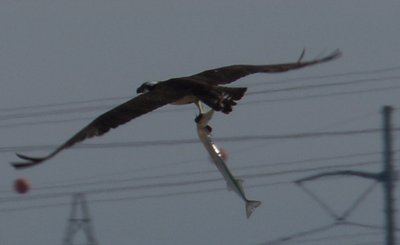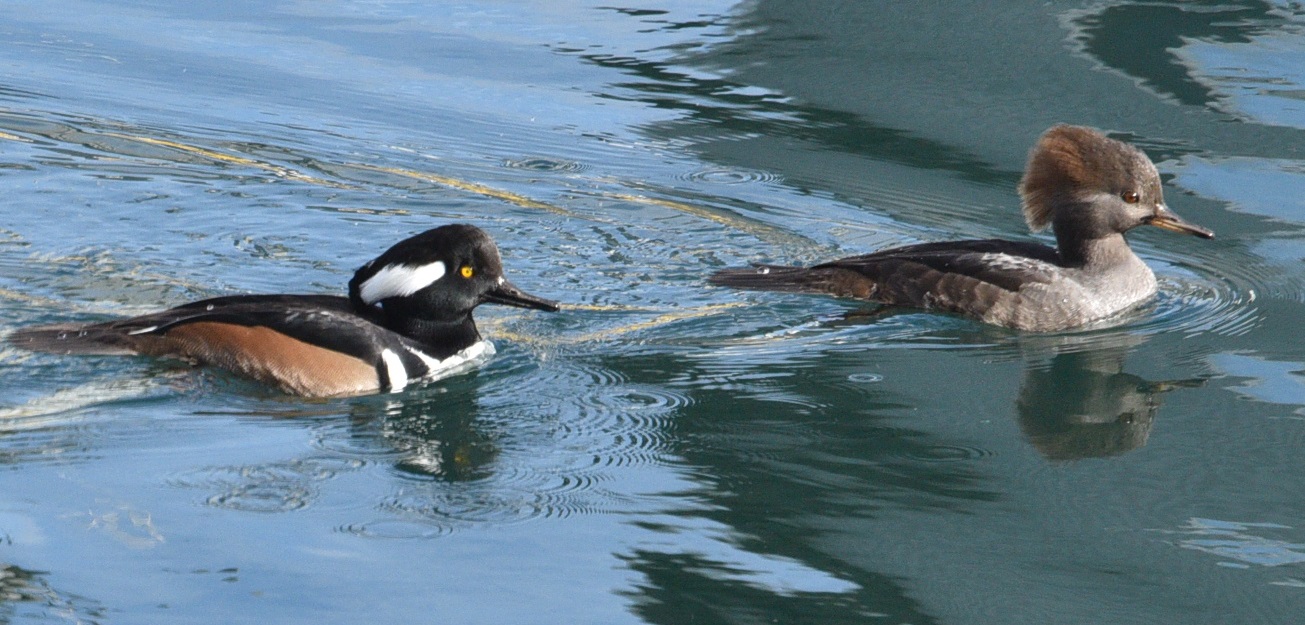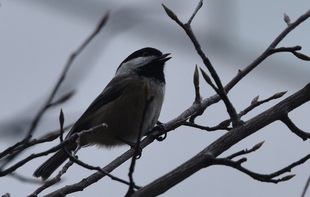52 Species and Counting...
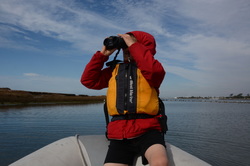
Coastal Birder Homo sapien L 48-72" W 48-72" Found sitting quietly holding a pair of binoculars or camera (Nikon 7100 w/ 18-200 mm lens or Nikon 810 w/ 24-300 lens) in a rubber boat studying the taxonomic class AVES. The red and yellow plumage is characteristic of a wREN, (short for LoRen) usually very active on the water but seen here uncharacteristically holding still on the South Bay of San Diego.
Common Name Order Family Genus Species sub-species Common Size (Birds grouped by ORDER within their taxonomic rank).
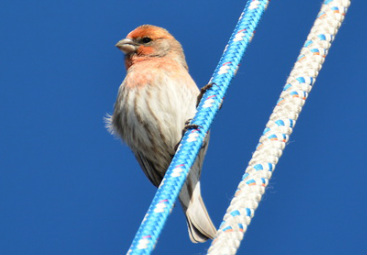
House Finch FRINGILLIDAE Carpodacu mexicanus L 6" Female. I took this photo moments after stepping out of our companion-way hatch aboard Steadfast and looked up into her rigging. (Chula Vista Marina; 1-14-14)
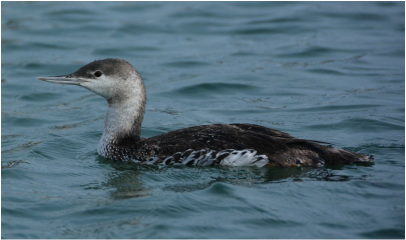
Pacific Loon GAVIIDAE Gavia pacifica L26" Junvenile. Breeds/summers in high latitudes of N. America. Winters along west coast, Alaska to Baja. Summers in northern provinces of Canada.
(Oxnard, Ca; 3-2015) Note: Could be a Red-throated Loon juvenile
Winters along west coast from Alaska to Baja.
(Oxnard, Ca; 3-2015) Note: Could be a Red-throated Loon juvenile
Winters along west coast from Alaska to Baja.
|
Common Loon GAVIIFORMES GAVIIDAE Gavia immer L 30" (75cm) W 45" (115cm) winter plumage
Agile swimmers, underwater hunters and fast flyers (70mph). Lifespan approx. 25yrs. Summers/breeds in throughout Canada but winters/feeds along most of the North American coastlines. Note: loons have solid bones, reducing buoyancy, enabling them to better pursue their underwater prey. (East of Hollywood Beach, Port Angeles, WA 12-1-2016) |
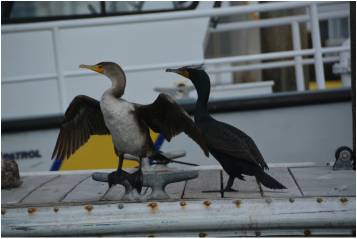
Double-crested Cormorant SULIFORMES PHALACROCORACIDAE Phalacrocorax auritus L32" (81cm) W52" (132cm) Large rounded yellow-orange throat patch is found year-round. Permanent resident along both coasts of the US. Breeds in the Midwest during the summer. Picture shows 1st year juvenile drying wings and breeding adult, 3+ yrs, with white tufts. (Channel Islands Marina, Oxnard, Ca; 3-2015)
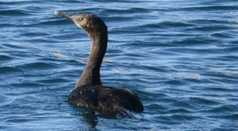
Pelagic Cormorant SULIFORMES PHALACROCORACIDAE Phalacrocorax pelagicus L 24" (60cm) W 43" (110cm) Oldest known age is 17 yrs in BC, Canada.
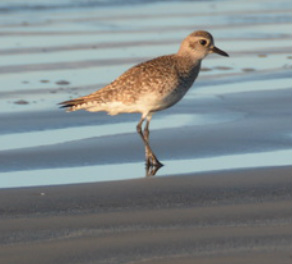
Pacific Golden-Plover Charadriiformes Charadriidae Pluvialis fulva L 9" (25 cm)
These species are uncommon along California's west coast/ central valley, most are in southern Asia and the Pacific Islands. Nice little find! (Ensenada, Mexico; 12-24-2013)
These species are uncommon along California's west coast/ central valley, most are in southern Asia and the Pacific Islands. Nice little find! (Ensenada, Mexico; 12-24-2013)
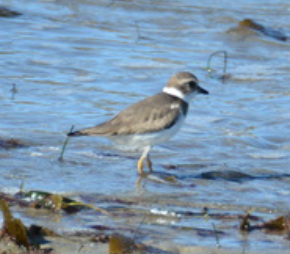
Semipalmated Plover Charadriiformes Charadriidae Dharadrius semipalmatus L 7" (18 cm)
These Plover's winter along the coasts of California and Baja feeding on crustaceans and worms. The "semipalmated" refers to the partial or reduced webbing between their toes. Characteristics; yellow legs (Ensenada, Mexico; 12-24-2013)
These Plover's winter along the coasts of California and Baja feeding on crustaceans and worms. The "semipalmated" refers to the partial or reduced webbing between their toes. Characteristics; yellow legs (Ensenada, Mexico; 12-24-2013)
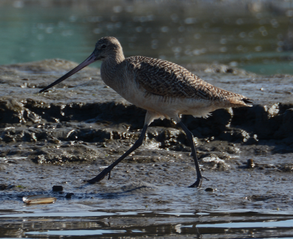
Marbled Godwit CHARADRIIFORMES SCOLOPACIDAE Limosa fedoa L 18" (46 cm) Male
You'll find this summer breeder in the Dakotas and Saskatchewan....but probably not. When was the last time you were in the prairie lands of North America? More likely...these stilt legged long billed shorebirds will be found feeding in the mudflats along the coasts of U.S. and Mexico during the winter months . (J Street Mudflats, South San Diego Bay, California; 12-17-2013)
You'll find this summer breeder in the Dakotas and Saskatchewan....but probably not. When was the last time you were in the prairie lands of North America? More likely...these stilt legged long billed shorebirds will be found feeding in the mudflats along the coasts of U.S. and Mexico during the winter months . (J Street Mudflats, South San Diego Bay, California; 12-17-2013)
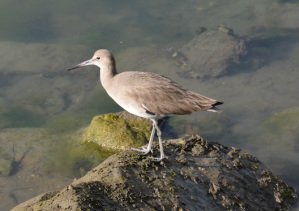
Willet CHARADRIIFORMES SCOLOPACIDAE Cataptrophorus semipalmatus L15" (38cm)
The grey legs help distinguish this bird from other SCOLOPACIDAES. Found wintering along the coasts of US and Mexico, or summering in middle US and Canada. (South San Diego, Ca; 1-8-2014)
The grey legs help distinguish this bird from other SCOLOPACIDAES. Found wintering along the coasts of US and Mexico, or summering in middle US and Canada. (South San Diego, Ca; 1-8-2014)

Sanderling CHARADRIIFORMES SCOLOPACIDAE Calidris alba L8" (20cm)
These cute little birds winter along the Pacific coast of California and Baja. In the summer they can be found in the highest latitudes above Canada. Shown here with its winter plumage, I photographed a flock of about 20 individuals feeding on small organisms within the sand of the local beaches of Ensenada, Mexico. (Punta Banda/ Ensenada, Baja Norte; 12-26-2013)
These cute little birds winter along the Pacific coast of California and Baja. In the summer they can be found in the highest latitudes above Canada. Shown here with its winter plumage, I photographed a flock of about 20 individuals feeding on small organisms within the sand of the local beaches of Ensenada, Mexico. (Punta Banda/ Ensenada, Baja Norte; 12-26-2013)
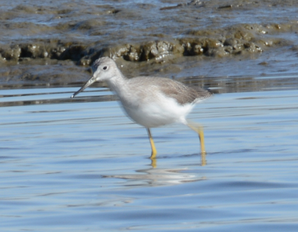
Greater Yellowlegs CHARADRIIFORMES Scolopacidae Tringa melanoleuca L 14" (36 cm)
A type of sandpiper, this shorebird winters on the west, gulf coast and Mexico in the winter and summers in northern Canada. (South San Diego Bay, California; 12-18-2013)
A type of sandpiper, this shorebird winters on the west, gulf coast and Mexico in the winter and summers in northern Canada. (South San Diego Bay, California; 12-18-2013)
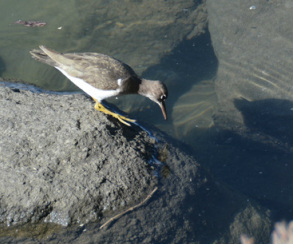
Spotted Sandpiper CHARADRIIFORMES SCOLOPACIDAE Actitis macularia L 7" (19cm)
I observed this bird solo, quickly hopping from rock to rock along the marina breakwater. (Chula Vista Marina, CA; 1-8-14)
I observed this bird solo, quickly hopping from rock to rock along the marina breakwater. (Chula Vista Marina, CA; 1-8-14)
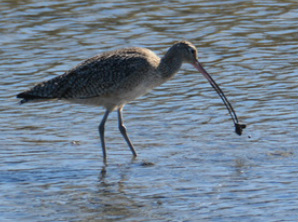
Long-billed Curlew CHARADRIIFORMES SCOLOPACIDAE Numenius americanus L23" (58cm)
Interesting to watch these Curlew's poke their long bills into the mud numerous times and come out with a crab or small clam surprise every so often. (Tijuana Estuary; 1-15-14)
Interesting to watch these Curlew's poke their long bills into the mud numerous times and come out with a crab or small clam surprise every so often. (Tijuana Estuary; 1-15-14)
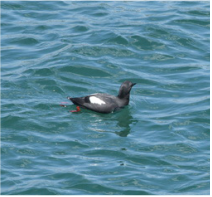
Pigeon Guillemot CHARADRIIFORMES ALCIDAE Cepphus columba L 12" ( 32cm ) W 22" (60cm)
These seabirds usually feed by surface diving in shallower depths (30-60 ft) than their auk and puffin cousins therefore are more common near shore. Note: They have been known to live up to 15 years Range; Alaska to California, (Monterey Bay, Ca; 4-27-16) (Port Townsend, Wa. 4-16-16)
These seabirds usually feed by surface diving in shallower depths (30-60 ft) than their auk and puffin cousins therefore are more common near shore. Note: They have been known to live up to 15 years Range; Alaska to California, (Monterey Bay, Ca; 4-27-16) (Port Townsend, Wa. 4-16-16)

Common Murre CHARADRIIFORMES ALCIDAE Uria aalge L 16' (40cm) W 27" (68cm)
Has been known to live 27 yrs (California), eggs roll in circles due to its pointed shape on one side (cliff nesters). Pictured: Non-breeding plumage (mid harbor, Port Angeles, Wa; 11-16)
Has been known to live 27 yrs (California), eggs roll in circles due to its pointed shape on one side (cliff nesters). Pictured: Non-breeding plumage (mid harbor, Port Angeles, Wa; 11-16)
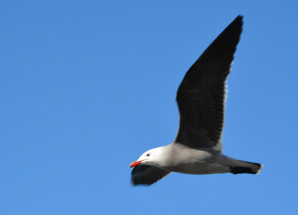
Heermann's Gull CHARADRIIFORMES LARIDAE Larus heermanni L19" (48cm) W51" (130cm)
When distinguishing from other gulls, this bird's strikingly orange-red bill will do the job. I enjoyed observing Heermann's Gulls during my studies in Bahia de los Angeles back in the late 1980's, but these "near threatened" birds can be seen dotted along the California coast and into Mexico. (Ensenada, Mexico; 12-26-2013) (Silver Stand State Beach; 1-10-14)
When distinguishing from other gulls, this bird's strikingly orange-red bill will do the job. I enjoyed observing Heermann's Gulls during my studies in Bahia de los Angeles back in the late 1980's, but these "near threatened" birds can be seen dotted along the California coast and into Mexico. (Ensenada, Mexico; 12-26-2013) (Silver Stand State Beach; 1-10-14)
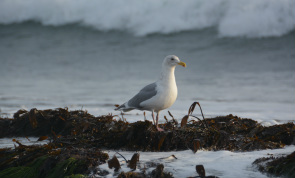
Western Gull CHARADRIIFORMES LARIDAE Larus occidentalis L25" (64cm) W58" (147cm)
You will have to travel to the coast of California or Northern Baja to catch a glimpse of this noble gull. A very common resident of Santa Cruz, this bird can be id'ed by its large size and...pink legs! (Santa Cruz, California; 1-1-2014)
You will have to travel to the coast of California or Northern Baja to catch a glimpse of this noble gull. A very common resident of Santa Cruz, this bird can be id'ed by its large size and...pink legs! (Santa Cruz, California; 1-1-2014)
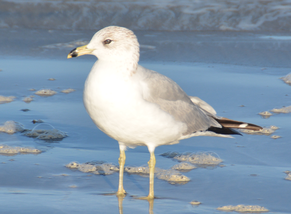
Ring-billed Gull CHARADRIIFORMES LARIDAE Larus delewaransis L17" (45vcm) W48" (122cm)
At least three years old. These "seagulls" are found thru-out California, the entire Southwest and Mexico during the winter and central Canada during the summer breeding season. (Silver Strand State Beach; 1-10-14)
At least three years old. These "seagulls" are found thru-out California, the entire Southwest and Mexico during the winter and central Canada during the summer breeding season. (Silver Strand State Beach; 1-10-14)
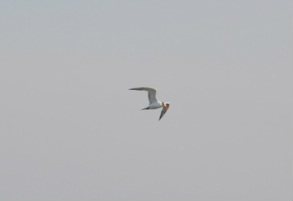
Caspian Tern CHARADRIIFOMRES LARIDAE Sterna (Hyroprognen) caspia L21" (53cm) W50" (127 cm) Similar to the Royal but bill is thicker and wingspan wider. (Chula Vista, Ca; 1-23-2014)
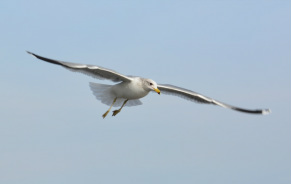
California Gull CHARADRIIFORMES LARIDAE Larus californicus L21" (53cm) W54" (137cm)
The species is referred to as a "four-year gull." In other words, it takes four summers to reach maturity. Shown here is an adult (at least four years old) during the winter. Commonly found around the California and Baja coastlines during the winter but breeds throughout the western region of the US and Canada. (Chula Vista, Ca; 1-23-2014)
The species is referred to as a "four-year gull." In other words, it takes four summers to reach maturity. Shown here is an adult (at least four years old) during the winter. Commonly found around the California and Baja coastlines during the winter but breeds throughout the western region of the US and Canada. (Chula Vista, Ca; 1-23-2014)
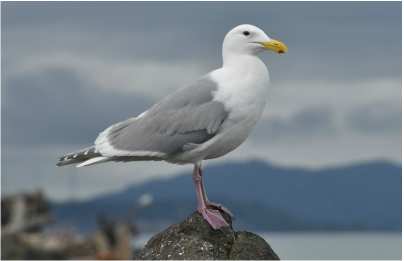
Glaucous-winged Gull CHARADRIIFORMES LARIDAE Larus occidentalis L 21" (54cm) W 52" (130cm)
Tdhe Glaucous-winged Gull hybridizes extensively with the Western Gull, with the hybrids being the most common form in Washington. (Port Angeles, Washingtion 4-15-16)
Tdhe Glaucous-winged Gull hybridizes extensively with the Western Gull, with the hybrids being the most common form in Washington. (Port Angeles, Washingtion 4-15-16)
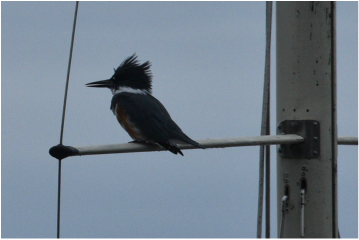
Belted Kingfisher CORACIIFORMES ALCEDINIDAE Megaceryle alcyon
L 12" (31cm) W 20" (52cm)
Common year-round in North America but still always a treat to see these ragged-crested birds diving from a sailboat spreader or bridge for fish. (Port Angeles Marina, WA 10/2016)
L 12" (31cm) W 20" (52cm)
Common year-round in North America but still always a treat to see these ragged-crested birds diving from a sailboat spreader or bridge for fish. (Port Angeles Marina, WA 10/2016)
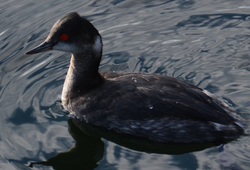
Eared Grebe Podicipediformes Podicipedidae Podiceps auritus L 13" (34 cm)
Another winter visitor along the California coast, Baja and Mexico these strong swimmers are a treat to see. I've noticed these crimson-eyed birds prefer to "fly" under water in pursuit of their next meal. (Chula Vista Marina, California; 12-2013)
Another winter visitor along the California coast, Baja and Mexico these strong swimmers are a treat to see. I've noticed these crimson-eyed birds prefer to "fly" under water in pursuit of their next meal. (Chula Vista Marina, California; 12-2013)
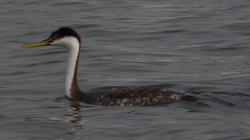
Western Grebe Podicipediformes PODICIPEDIDAE Aechmorphorus occidentalis L 25" (65 cm)
A permanent California resident, Grebes are rarely seen flying...above water. Look at how low this bird sits in the water...they have little interest in buoyancy. Grebes are swift and strong underwater fliers, easily escaping nosy birders, i.e. me, and, or pursuing small fish and bottom dwelling algae. (Chula Vista Marina, California; 12-18-2013)
A permanent California resident, Grebes are rarely seen flying...above water. Look at how low this bird sits in the water...they have little interest in buoyancy. Grebes are swift and strong underwater fliers, easily escaping nosy birders, i.e. me, and, or pursuing small fish and bottom dwelling algae. (Chula Vista Marina, California; 12-18-2013)
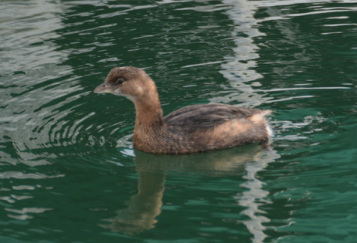
Pied-billed Grebe Podicipediformes PODICIPEDIDAE Podilymbus podiceps
A common sight in San Diego Bay. These small Grebes like their cousins, dive for their prey. Many live year-round in most of North American. (Chula Vista, Ca; 1-24-14)
A common sight in San Diego Bay. These small Grebes like their cousins, dive for their prey. Many live year-round in most of North American. (Chula Vista, Ca; 1-24-14)
(Below) Osprey ACCIPITRIFORMES PANDIONIDAE Pandion haliaetus L 25" (64 cm) W 72" (183 cm)
I saw my first Osprey and Osprey nest while traveling thru Baja back in 1989, where they are considered residents. Here in Chula Vista Marina I frequently spot this "fish-hawk" perched on top of a 60' sailboat mast ripping apart and devouring a freshly caught mackerel using its razor-sharp beak and talons. I was lucky to grab the shot on the right after my camera "chocked." The fish in the talons looks to be a 20-24" 10-15 lb. barracuda! Wow, what a cool bird. (South San Diego Bay, California; 11-2013, 12-18-2013)
I saw my first Osprey and Osprey nest while traveling thru Baja back in 1989, where they are considered residents. Here in Chula Vista Marina I frequently spot this "fish-hawk" perched on top of a 60' sailboat mast ripping apart and devouring a freshly caught mackerel using its razor-sharp beak and talons. I was lucky to grab the shot on the right after my camera "chocked." The fish in the talons looks to be a 20-24" 10-15 lb. barracuda! Wow, what a cool bird. (South San Diego Bay, California; 11-2013, 12-18-2013)

Northern Harrier ACCIPITRIFORMES ACCIPITRIDAE Circus cyaneus L20" (50cm) W42" (100cm) Female I was told only the females, identified by their brown plumage, frequented the region around the Tijuana Estuary. With binoculars, you can really notice the "owl-faces' on these birds. I snapped this picture from quite a distance as it flew over a protected reserve. (Tijuana Estuary; 1-15-14)
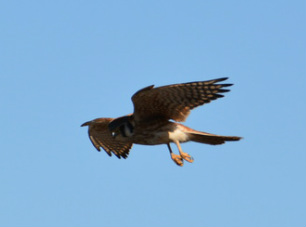
American Kestrel FALCONIFORMES FALCONIDAE Falco sparverius L10" (27cm) W23" (58cm)
Found perched on a perimeter fence of a Navy airport, these are the smallest and most common falcons in the US. (Tijuana Estuary/Imperial Beach Aviation Field; 1-15-14)
Found perched on a perimeter fence of a Navy airport, these are the smallest and most common falcons in the US. (Tijuana Estuary/Imperial Beach Aviation Field; 1-15-14)
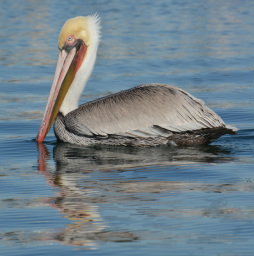
Brown Pelican PELECANIFORMES PELECANIDAE Pelecanus occidentalis L 48" (122 cm) W 84" (213 cm)
Known to live up to 43 years old these large billed birds are commonly found year-round along the coasts of U.S. and Mexico. This particular bird (right), with its yellow head, white neck and reddish bill signifies a non-breeding 3-5 year old adult. (Chula Vista Marina, California; 12-17-2013)
Known to live up to 43 years old these large billed birds are commonly found year-round along the coasts of U.S. and Mexico. This particular bird (right), with its yellow head, white neck and reddish bill signifies a non-breeding 3-5 year old adult. (Chula Vista Marina, California; 12-17-2013)
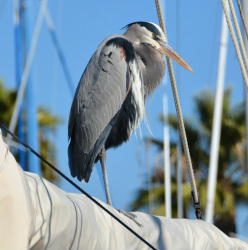
Great Blue Heron Pelicaniformes Ardeidae Ardea herodias L 46" (117 cm) W 72" (183 cm)
A common sight throughout the U.S. This particular one frequents our docks at night. Every time I go ashore I have to bother this fellow to fly away. (Chula Vista Marina, California; 12-2013)
A common sight throughout the U.S. This particular one frequents our docks at night. Every time I go ashore I have to bother this fellow to fly away. (Chula Vista Marina, California; 12-2013)
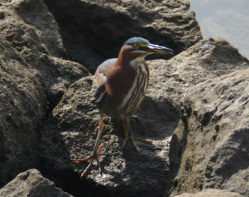
Green Heron PELICANIFORMES ARDEIDAE Butorides virescens L18" (46cm) W26" (66cm)
Permanent resident of the west coast of the US, Mexcio and Florida. I found this bird
frozen in place, patiently waiting for the perfect moment to nab a small fish hiding near some rocks among the marina breakwater. (Chula Vista Marina, CA; 1-8-14)
Permanent resident of the west coast of the US, Mexcio and Florida. I found this bird
frozen in place, patiently waiting for the perfect moment to nab a small fish hiding near some rocks among the marina breakwater. (Chula Vista Marina, CA; 1-8-14)
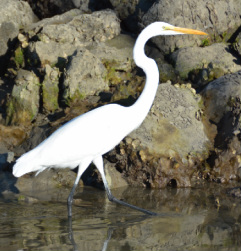
Great Egret Pelicaniformes Ardeidae Ardea alba L 39" (100 cm) W 51" (130 cm)
The Great Egret winters in the San Diego area... so telling the Snowy and Great apart is really only a seasonal concern ;). If you happen to be in a region where the two birds overlap look at the color of their beaks and feet. The Great's body and wingspan is larger. They both patiently stalk fish from the shallow waters of a marina or estuary then seize the prey with a lightning fast strike with their long necks and beaks. (Chula Vista Marina, California; 11-2013)
The Great Egret winters in the San Diego area... so telling the Snowy and Great apart is really only a seasonal concern ;). If you happen to be in a region where the two birds overlap look at the color of their beaks and feet. The Great's body and wingspan is larger. They both patiently stalk fish from the shallow waters of a marina or estuary then seize the prey with a lightning fast strike with their long necks and beaks. (Chula Vista Marina, California; 11-2013)
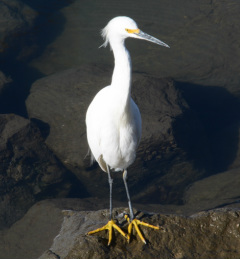
Snowy Egret Pelicaniformes Ardeidae Egretta thula L 24" (61 cm) W 41" (104 cm)
These permanent residents of South San Diego Bay are commonly found standing along the shallows of the marina rip-rap. Though more skittish than their cousins, the Great Blue Heron, I should have plenty of opportunities to practice my photographic skill on these deft fish hunters. (Chula Vista Marina, California; 11-2013)
These permanent residents of South San Diego Bay are commonly found standing along the shallows of the marina rip-rap. Though more skittish than their cousins, the Great Blue Heron, I should have plenty of opportunities to practice my photographic skill on these deft fish hunters. (Chula Vista Marina, California; 11-2013)
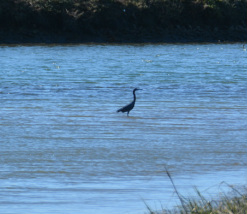
Little Blue Heron Pelicaniformes Ardeidae Egretta caerulea L24" (61cm) W40" (102cm)
Hard to appreciate in this picture, these Heron's wear a rich slate blue plumage during their non-breeding season. Uncommon along the west coast of the US this bird is more abundant around the Gulf states. (Tijuana Estuary; 1-15-14)
Hard to appreciate in this picture, these Heron's wear a rich slate blue plumage during their non-breeding season. Uncommon along the west coast of the US this bird is more abundant around the Gulf states. (Tijuana Estuary; 1-15-14)
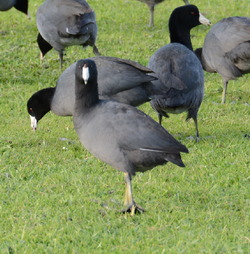
American Coot Gruiformes Rallidae Fulica americana L 15" (39 cm)
Permanent residents throughout the north and southwest of the U.S. and Mexico, these birds are a common sight. I often see Coots (or Mud Hens, as a friend in SC calls them) diving in marinas or shallow bays feeding on green algae. (Chula Vista Marina, California; 11-2013)
Permanent residents throughout the north and southwest of the U.S. and Mexico, these birds are a common sight. I often see Coots (or Mud Hens, as a friend in SC calls them) diving in marinas or shallow bays feeding on green algae. (Chula Vista Marina, California; 11-2013)

Surf Scoter ANSERIFORMES ANATIDAE Melanitta perspicillata L 20" (51 cm) Male
One of my favorites. Scoters breed in Northern Canada and Alaska during the summers so I only get to see these guys during the winter months. Living in Boulder, CO over the past five winters denied my "Scoter" fix. Returning to Santa Cruz this February allowed me to view the small flock that frequents the harbor entrance. And now that winter is near and we have remained along the coast, ie San Diego, I have more opportunities to see these "snowbirds" hanging out. (Chula Vista Marina, California; 12-10-2013) (1-10-14)
One of my favorites. Scoters breed in Northern Canada and Alaska during the summers so I only get to see these guys during the winter months. Living in Boulder, CO over the past five winters denied my "Scoter" fix. Returning to Santa Cruz this February allowed me to view the small flock that frequents the harbor entrance. And now that winter is near and we have remained along the coast, ie San Diego, I have more opportunities to see these "snowbirds" hanging out. (Chula Vista Marina, California; 12-10-2013) (1-10-14)
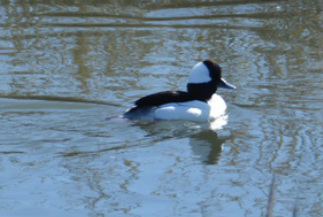
Bufflehead ANSERIFORMES ANATIDAE Bucephala albeola L 13" (34 cm) Male
I found this adult male while hiking around the Tijuana Slough. Though it was pretty far from shore this sea-duck really stood out due to its highly contrasting black and white pattern and steep forehead. (South San Diego Bay, California; 12-3013)
I found this adult male while hiking around the Tijuana Slough. Though it was pretty far from shore this sea-duck really stood out due to its highly contrasting black and white pattern and steep forehead. (South San Diego Bay, California; 12-3013)
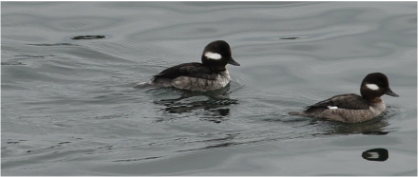
Bufflehead ANSERIFORMES ANATIDAE Bucephala albeola
Female Female Buffleheads are significantly smaller than their male counterparts, possibly mistaking these sea ducks as juveniles. Travelling north along the shores of Diablo Bay I found a large group of female Buffleheads , north of Olympia, Washington. (Potlatch State Park, Washingtion 4-14-16)
Female Female Buffleheads are significantly smaller than their male counterparts, possibly mistaking these sea ducks as juveniles. Travelling north along the shores of Diablo Bay I found a large group of female Buffleheads , north of Olympia, Washington. (Potlatch State Park, Washingtion 4-14-16)

Lesser Scaup ANSERIFORMES ANATIDAE Anatidae Aythya affinis L16" (42 cm) Male
Found wintering in most of the lower forty-eights and Mexico and summering in Canada, Scaups are one of the many types of ducks that display sexual dimorphism; an obvious difference between males and females. (Chula Vista Marina, California; 12-2013)
Found wintering in most of the lower forty-eights and Mexico and summering in Canada, Scaups are one of the many types of ducks that display sexual dimorphism; an obvious difference between males and females. (Chula Vista Marina, California; 12-2013)
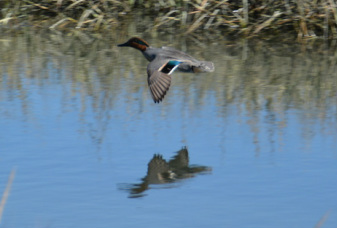
Green-winged Teal ANSERIFORMES ANATIDAE Anas crecca L 14" (37 cm) male
The Green-winged is just visiting for the winter, preferring Canada in the summer. (Tijuana Estuary/ J Street Mudflats, Chula Vista; 1-2014)
The Green-winged is just visiting for the winter, preferring Canada in the summer. (Tijuana Estuary/ J Street Mudflats, Chula Vista; 1-2014)
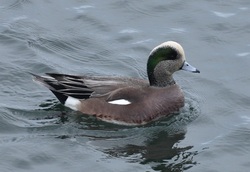
American Wigeon ANSERIFORMES ANATIDAE Anas americana L 20" (50cm) W 30" (84cm) Male
Summers/breeds in Canada and Alaska, Winters along west coast, the southern states, Mexico. Columbia and Venezuala. Found in or near estuaries along the west coast. ( Tijuana Estuary/ J Street Mudflats, Chula Vista, CA; 1-2014, East of Hollywood Beach, Port Angeles, WA 12-1-2016)
Summers/breeds in Canada and Alaska, Winters along west coast, the southern states, Mexico. Columbia and Venezuala. Found in or near estuaries along the west coast. ( Tijuana Estuary/ J Street Mudflats, Chula Vista, CA; 1-2014, East of Hollywood Beach, Port Angeles, WA 12-1-2016)

Mallard ANSERIFORMES ANATIDAE Anas platyrhynchos L 22" (60 cm)
This most common duck is found in most of the lower forty-eights and Mexico year-round or Canada and Alaska in the summer breeding months. (Balboa Park, San Diego, California; 12-10-2013)
This most common duck is found in most of the lower forty-eights and Mexico year-round or Canada and Alaska in the summer breeding months. (Balboa Park, San Diego, California; 12-10-2013)
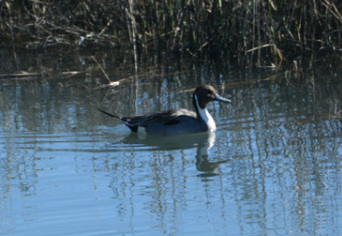
Northern Pintail ANSERIFORMES ANATIDAE Anas acuta L 26" (66cm) - male
A common duck, found in most of North America. The white pattern along the long, slender neck and black central tail feather was the give-a-way. (J Street Mudflats, South San Diego, California; 1-5-2014)
A common duck, found in most of North America. The white pattern along the long, slender neck and black central tail feather was the give-a-way. (J Street Mudflats, South San Diego, California; 1-5-2014)
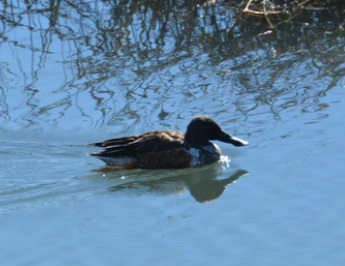
Northern Shoveler ANSERIFORMES ANATIDAE Anas clypeata L 19" (48cm)
Picture not great but you can still appreciate that large spatula shaped bill that makes these birds unique. This Shoveler is showing it's drab winter plumage. In the summer the males display vibrant colors similar to the Mallard. Found wintering throughout the lower US and Mexico.
(South San Diego, California; 1-5-2014)
Picture not great but you can still appreciate that large spatula shaped bill that makes these birds unique. This Shoveler is showing it's drab winter plumage. In the summer the males display vibrant colors similar to the Mallard. Found wintering throughout the lower US and Mexico.
(South San Diego, California; 1-5-2014)
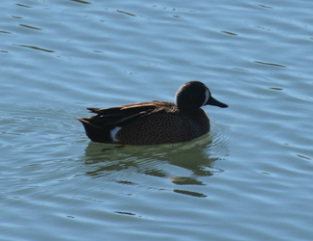
Blue-winged Teal ANSERIFORMES ANATIDAE Anas dicors L 15" (39cm)
The white crecent shape on each side of it's head identifies this male Blue-winged Teal. Winters along the California, Baja and Mexican coasts, summers throughout the upper US and Canada. (South San Diego, California; 1-5-2014)
The white crecent shape on each side of it's head identifies this male Blue-winged Teal. Winters along the California, Baja and Mexican coasts, summers throughout the upper US and Canada. (South San Diego, California; 1-5-2014)
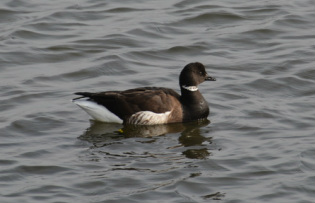
Brant ANSERIFORMES ANATIDAE Branta bernicla nigricans L25" (64cm)
Rarely seen inland, this sea goose is winter resident along the west coast of the US and Baja but summers/breeds among the high latitudes of Canada and Alaska. I observed hundreds of these adults throughout the J Street Mudflats hanging with mostly Green-winged Teals. (Chula Vista, Ca; 1-23-2014)
Rarely seen inland, this sea goose is winter resident along the west coast of the US and Baja but summers/breeds among the high latitudes of Canada and Alaska. I observed hundreds of these adults throughout the J Street Mudflats hanging with mostly Green-winged Teals. (Chula Vista, Ca; 1-23-2014)
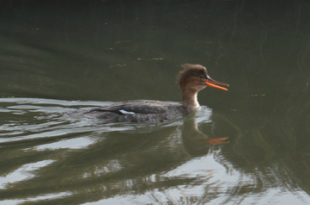
Red-breasted Merganser ANSERIFOMRES ANATIDAE Mergus serrator L23" (58cm) Female
Prefers brackish or salt water in winter along the East and West coasts of the US and Baja. Breeds in Canada and Alaska during the summer months. (Chula Vista/ J Street Mudflats, Ca; 1-23-2014)
Prefers brackish or salt water in winter along the East and West coasts of the US and Baja. Breeds in Canada and Alaska during the summer months. (Chula Vista/ J Street Mudflats, Ca; 1-23-2014)
|
Hooded Merganser ANSERIFORMES ANATIDAE Lophodytes cucullatus L 17" (45cm) W 24.5" (63cm)
From afar, I have mistaken the males with the local male/female buffleheads due to the large white patch on the head while the female hooded are distinctly cinnamon colored. The bill is narrower than the bufflehead. these sea-ducks nest in tree cavities making the spruce-fir forest found along the coasts of the strait of juan de fuca ideal year-round. Surface divers. (Valley Creek Estuary Park, Port Angeles, WA. 11-29-16) |
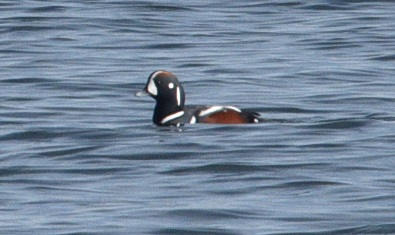
Harlequin Duck ANSERIFORMES ANATIDAE Histrionicus histrionicus
L18" (40cm) W 24" (60cm)
Found wintering near the mouth of valley creek. One of these ducks was spotted after being tagged 20 years ago in BC, Canada. Typical male/female dimorphism, intricately colored/patterned male, less so the female, mostly brown with small white patch.
L18" (40cm) W 24" (60cm)
Found wintering near the mouth of valley creek. One of these ducks was spotted after being tagged 20 years ago in BC, Canada. Typical male/female dimorphism, intricately colored/patterned male, less so the female, mostly brown with small white patch.
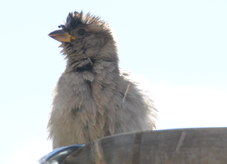
Golden-crowned Sparrow PASSERIFORMES EMBERIZIDAE Zonotrichia atricapilla L7" (18 cm)
This immature Sparrow was caught taking a bath in a fountain near the harbor office at Chula Vista Marina, hence its "fluffled body and mohawk" look. Golden-crowns breed in Western Canada and Alaska during the summer months but winter along the west coast, from Washington to northern Baja. (Chula Vista Marina, California; 12-16-2013)
This immature Sparrow was caught taking a bath in a fountain near the harbor office at Chula Vista Marina, hence its "fluffled body and mohawk" look. Golden-crowns breed in Western Canada and Alaska during the summer months but winter along the west coast, from Washington to northern Baja. (Chula Vista Marina, California; 12-16-2013)
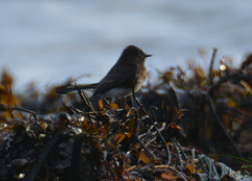
Black Phoebe PASSERIFORMES TYRANNIDAE Sayornis nigricans L 6" (16 cm)
This "flycatcher" was found amongst the exposed giant kelp at Natural Bridges tide pools. Known to feed on an assortment of insects, including "kelp flies", Black Phoebes will be seen all year along the entire coast of California and throughout most of Baja and Mexico. (Santa Cruz, California; 1-1-2014) (Chula Vista, CA; 1-5-2014)
This "flycatcher" was found amongst the exposed giant kelp at Natural Bridges tide pools. Known to feed on an assortment of insects, including "kelp flies", Black Phoebes will be seen all year along the entire coast of California and throughout most of Baja and Mexico. (Santa Cruz, California; 1-1-2014) (Chula Vista, CA; 1-5-2014)
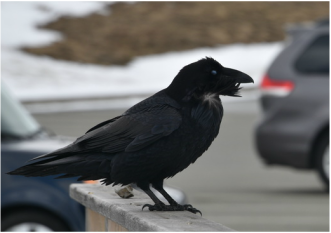
Common Raven PASSERIFORMES CORVIDAE Corvus corax
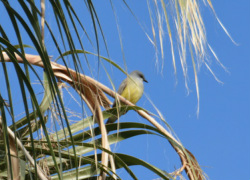
MacGillivray's Warbler PASSERIFORMES PARULIDAE Oporornis tolmiei L5" (13cm)
Interesting sighting since the records say this bird should be in central Mexico now. Their summer breeding grounds in Northern Cali isn't far off so maybe some of these Warblers are a little slow heading south or just thought San Diego weather was "good enough". (Chula Vista, CA; 1-7-2014)
Interesting sighting since the records say this bird should be in central Mexico now. Their summer breeding grounds in Northern Cali isn't far off so maybe some of these Warblers are a little slow heading south or just thought San Diego weather was "good enough". (Chula Vista, CA; 1-7-2014)
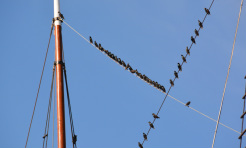
European Starling PASSERIFORMES STURNIDAE Sturnus vulgaris L8" (22cm)
First brought to North America by Shakespeare enthusiasts in the 19th century, these birds are now among the continent's most numerous songbirds. (Aboard the tallship "Bill of Rights", Chula Vista Marina, CA; 1-7-2014)
First brought to North America by Shakespeare enthusiasts in the 19th century, these birds are now among the continent's most numerous songbirds. (Aboard the tallship "Bill of Rights", Chula Vista Marina, CA; 1-7-2014)
Copyright © 2009-2020 Hansen-Dahlin — All Rights Reserved


